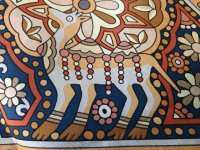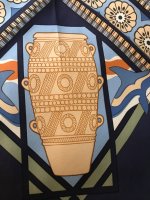Here is my on theme scarf today. Kermit Oliver's Les Cheyennes.
I initially resisted buying scarves that depict people from another culture or seem to appropriate another culture. I broke that rule for Kermit Oliver.
Oliver's father's family were enslaved people, brought from St. Louis to work at ranches in South Texas. His mother's side of the family was white, of Irish and German American descent. His father was a cowboy, and Oliver was raised in Refugio amidst a blend Black, Hispanic, Latino, and white cultures.
Oliver majored in fine art and education at Texas Southern University, where he met and married a fellow art student, Katie.
A young black man, Oliver was uncertain he would succeed in the art world and expected he would teach art. He did teach for three years, but in 1970 had a solo show at a major Houston gallery, earning a solid following.
Although highly successful, Oliver constantly felt like an outsider. In 1978, Oliver began working as a processor at a Houston post office.
In 1980, Hermes was searching for an American painter who could design a southwestern-themed scarf. One of his patrons, Lawrence Marcus, executive vice president of Neiman Marcus, was asked for suggestions. He immediately thought of Kermit Oliver and recommended him. Xavier Guerrand-Hermes, then president of US operations, visited Oliver at his home in Houston and was impressed by Oliver's work.
Guerrand-Hermes asked Oliver to select one of three subjects to paint: something southwestern, the history of Neiman Marcus, or a Native American subject. Oliver chose to illustrate a Native American subject, resulting in his Pawnee chief scarf, Pani la Shar.
In 1984 Kermit Oliver and Katie moved to Waco to care for Katie's grandmother. He continued to work for the local post office, painting little, only undertaking commissions and scarf designs.
Oliver had a strong Christian faith and a deep knowledge of the Bible. This, combined with his knowledge of the natural world, informed his art. Much of his painting is rich in symbolism, and he was influenced by Carl Jung's book, Symbols of Transformation. The cycle of birth, life, death and rebirth recurs in his work.
Oliver's life took a tragic turn when one of his children, Khristian, who had fallen in with a bad crowd, was caught up in a burglary. Khristian, his pregnant girlfriend, and two other boys decided to break into a house. When the owner came home, he shot one of the boys, and Kristian then shot and beat the owner, killing him.
Khristian was sentenced to death, and over the next ten years, Kermit would paint to raise money to pay attorneys' fees. The art world rallied to support Kermit, and Hermes ordered fifteen additional color variations on existing scarves from Kermit for $500,000. (Hermes kept all the rights.)
While Khristian remained in prison, he and Kermit exchanged artwork. Like his father, Khristian often painted animals, and Kermit would challenge Khristian to replicate his compositions. On November 5, 2009, Khristian was put to death by lethal injection with both Kermit and Katie present.
Khristian's death has informed Kermit's art and his ideas about God and life.
I am wearing Les Cheyennes (reissued as Les Plumes de l'Ouest after they Cheyennes objected) today, designed by Kermit Oliver in 1993.
(Other Oliver scarves - dates according to Carre de Paris and piwigo - Kachinas, 1992; Les Ameriques, 1992; Faune at Flore du Texas, 1992; Pony Express, 1993; Les Mythologies des Hommes Rouges, 1994; Naturalia, 1994; Les Danses des Indiens, 1999; Madison Ave, 2000; Concours d'Elegance, 2002, Tsitsika, 2002; Le Canada, 2006; Marquis de Lafayette, 2007; La Vie Sauvage du Texas; Chefs Indiens, 2014)
View attachment 4928143
 .
.  forum.purseblog.com
forum.purseblog.com
 .
. 




 )
)

















